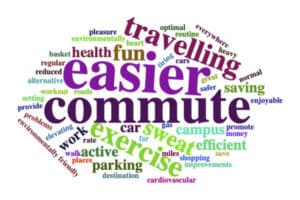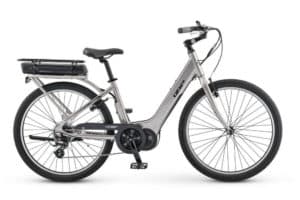Every now and then, ebike riders are certainly still sneered at by other people in everyday life. For example, when it comes to the question of whether riding with the support of the motor has a positive effect on the body at all. The electric drive does all the work, they sometimes say. A study from the USA shows how unjustified this assumption is.
In the land of unlimited opportunities, many people have reduced their physical activity to a very limited level. Most adults spend more time being sedentary than being active during the day. Only a minority of the population gets the minimum 150 minutes of moderate physical activity per week recommended by the US Department of Health. The reasons for this sound very similar in our country: Driving a car is much more comfortable. Sitting is part of the job. There is not enough time for sports or the like. Researchers at Miami University – which, contrary to its name, is based in Oxford in the US state of Ohio and not in Florida – wanted to know whether even something as ordinary as commuting to work can change the situation. After all, even in the age of home offices, many people still leave their homes every day to pursue their jobs.
Simply change the mode of transport
So the researchers recreated exactly this situation. A distance of three miles, or about 4.8 kilometres, which is also quite typical on a European scale, should suddenly no longer be covered by car or public transport, but by bicycle. Thirty people took part in the experiment, 14 women and 16 men aged between 19 and 61. During the day, they rode their laps on a flat oval at different times of the year in the service of science. Sensors continuously recorded heart rate, oxygen consumption, calories burned and measured time on each ride. At the end of a route, they were asked to rate how strenuous they had found the ride.

The table shows that the group of participants was relatively young and fit. Therefore, the researchers recommend for future studies, among other things, the stronger inclusion of older people.
Since the study was to examine the effect of riding an ebike, the participants of course cycled on ebikes. More precisely, it was a model for the US market. Its TransX mid-motor had a power output of 350 watts, more than the 250 watts allowed for pedelecs in Europe. However, the support ended at a speed of 20 miles per hour, which is pretty much the same as the 25 km/h that is usual here.
Analysis at different physical strain
A normal touring bike with a 21-speed derailleur and a weight of 13.4 kilograms served as a reference value. This was more than ten kilograms lighter than the ebike. Of course, it lacked a motor. On the other hand, the participants were not allowed to use the motor on the ebike at will. The requirement was to complete runs in the lowest assist level and in the medium assist level. Three of each, so that each person cycled the three miles to the pretended workplace nine times. The researchers chose to avoid riding in the highest of the three assist levels so as not to overwhelm the participants who had no ebike experience. They wanted to prevent anyone from being taken into a situation that was perceived as threatening. At the same time, there was no set pace. Everyone could choose the speed they felt comfortable with on each of the three bikes.
In comparison, riding a regular bicycle proved to be the most physically demanding exercise. The researchers found significant differences between riding an ebike at assist level 1 and riding an ebike at assist level 2. differences. In all recorded parameters, the bicycle without e-drive was clearly beyond the two ebike options. However, another observation was at least as important and probably less predictable for the researchers: even if riding an ebike is perceived as less strenuous, the intensity still has a positive effect on the physique of the participants. Crucial cardiometabolic values such as heart rate and oxygen consumption were within or close to what the US Department of Health and Human Services defines as moderate intensity – even when riding with moderate assistance. Therefore, the researchers conclude that ebike use can promote health-related fitness.
Good reasons for a change
For everyday life, also quite interesting to know: Participants took about 25 percent more time to ride a regular bike. So, under certain circumstances, ebike riders can reach their destination much faster than people on a regular bike. In practice, however, traffic light phases and other general conditions are likely to shrink this time gain again.
Basically, the study published in 2021 comes to an optimistic conclusion. Above all, the lower level of exertion and the time saved could encourage people to switch to the ebike. This, in turn, would benefit their health and not least the creation of a climate-friendly coexistence. After the test, at least the vast majority of participants would have had a more positive or unchanged attitude towards riding an ebike.

With words like “easier”, “commute” and “travelling”, the participants of the study outlined the biggest advantages of ebikes.
Study:
Alessio, Helaine M.; Reiman, Timothy; Kemper, Brett; von Carlowitz, Winston; Bailer, A. John; Timmerman, Kyle L.. Metabolic and Cardiovascular Responses to a Simulated Commute on an E-Bike. Translational Journal of the ACSM: Spring 2021 – Volume 6 – Issue 2 – e000155 doi: 10.1249/TJX.0000000000000155
Pictures: Coboc; Translational Journal of the ACSM; Alta Cycling Group

